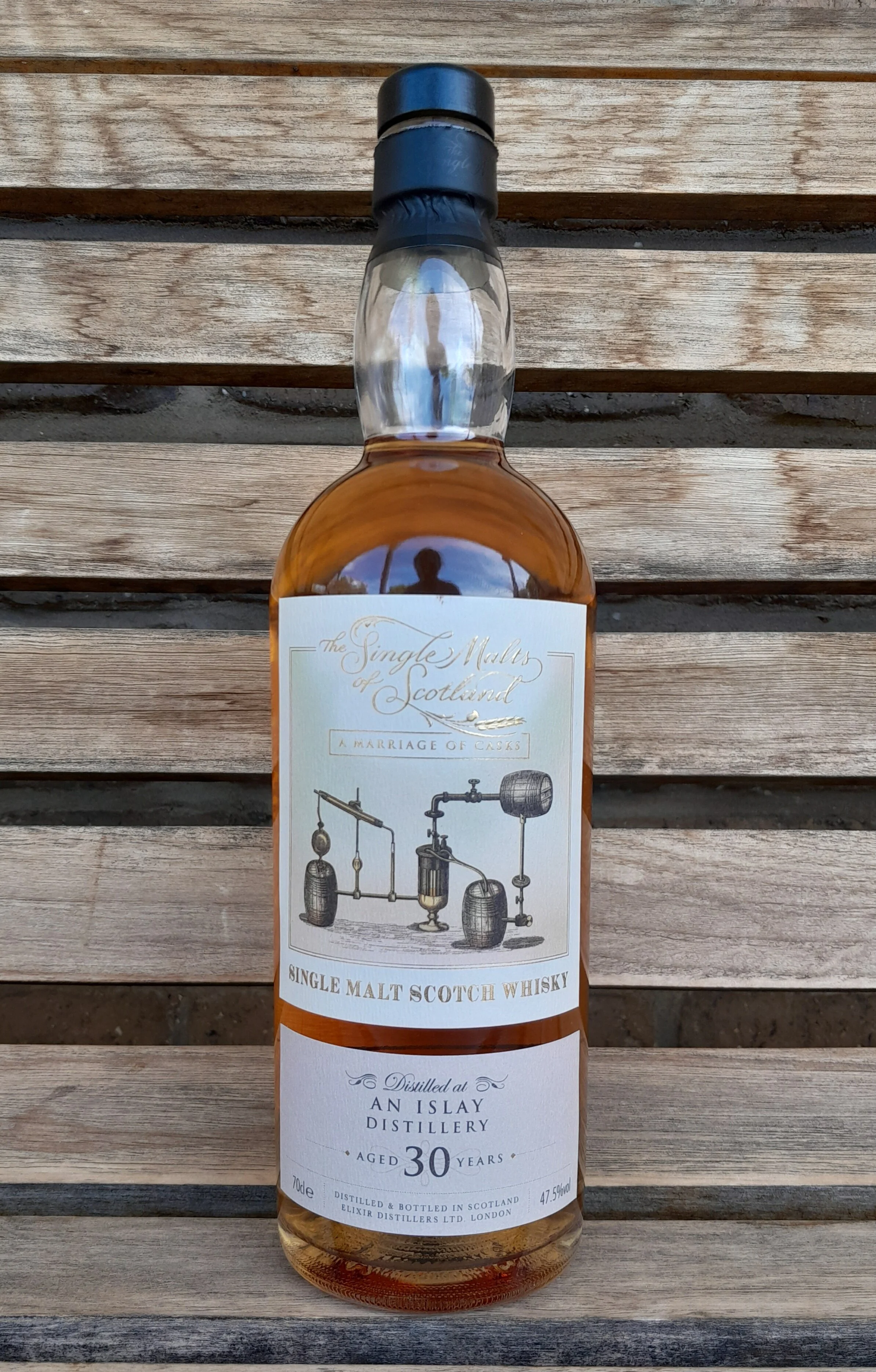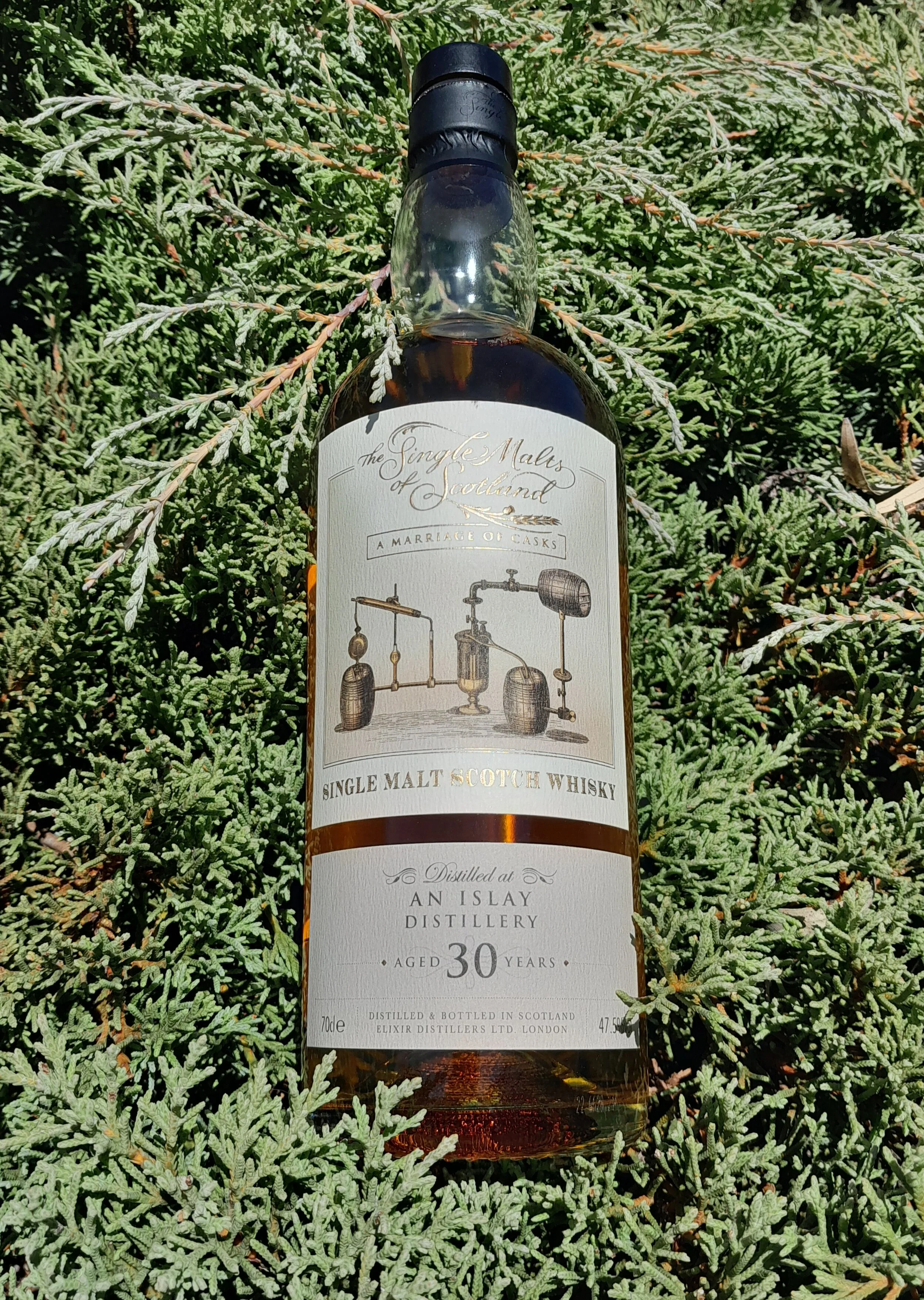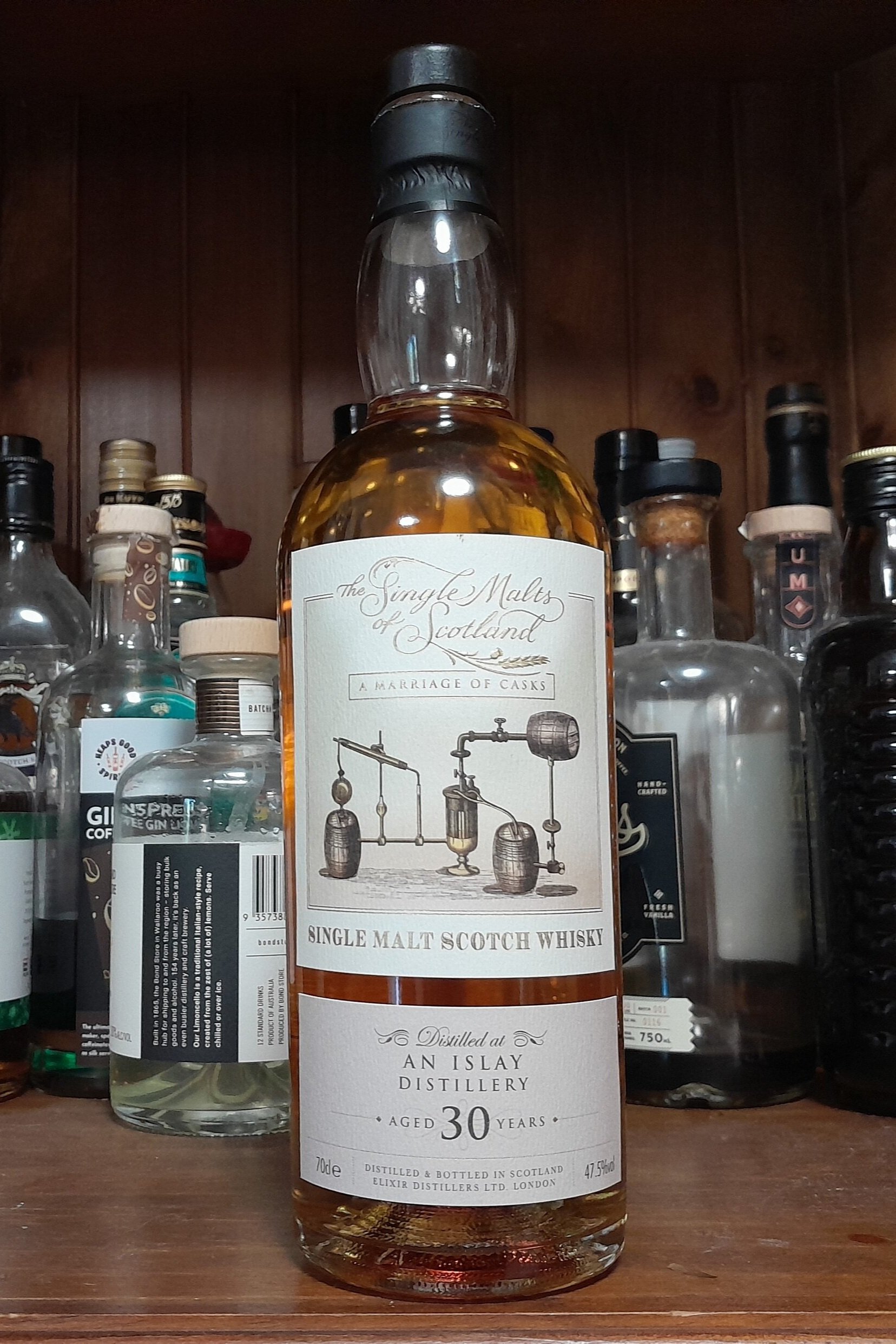SMOS "An Islay Distillery" 30yo
A marriage of casks | 47.5% ABV
Score: 9/10
Exceptional
TL;DR
An utter show stopper.
I like to drink it
Though most of what I write for Dramface tends to be oriented to production science, organoleptic analysis or some other geeky offshoot of the industry, my favourite part of whisky is still drinking it. Whether it be at home in quiet isolation, with friends at a tasting or just about anywhere else, whisky is a happy place.
I’m sure the way many of my articles are written, it might seem like I’m a bit of a wet flannel. Certainly I wouldn’t argue with anyone that knows me personally and made that assertion. But when it comes to whisky, I’m a pretty passionate guy. There has to be a certain amount of passion and dedication to reorient one’s professional endeavours because of a beverage, and as just about anyone already in the industry will tell you, there’s not a lot of money or fame to be had in it for the vast majority. No, it is one of the few industries I’ve seen which motivates people to give up so many hours, brain cells and liver-toxicology scores without wider compensation.
I can’t remember whether I’ve mentioned it on this site before, but the plan my wife and I are currently working on is a permanent relocation from Australia to Scotland so that I can study brewing and distilling at Heriot-Watt university. It’s a daunting prospect. Changing continents, leaving friends and family behind, starting a degree in my mid-20s and so many other, smaller issues that complicate the matter. What’s more, we’ll be spending basically our life savings in order to do so. We’re still a ways out; all going to plan, the move won’t be happening until late next year at the absolute earliest, and more probably some time in 2025. All the same, I’m occasionally struck by something like a panic attack thinking about it. There are so many things I’m ill prepared for, so many life skills I still haven’t developed, and so many safety nets that will be left on the other side of the globe.
Compounding my anxiety is the fact that my wife, darling as she is, fully supports my dream of becoming qualified and joining the industry in earnest, but I can’t help but feel guilty too. I’ll be pulling her away from our Australian lives too, both of us starting from a blank slate, except for one another. She is, in her typically stoic and brave fashion, excited by the prospect of the whole thing. She admits it will be a culture shock at first, but has fully committed to our imminent whisky lives. But that anxiety eats at me, in the quiet moments between wakefulness and sleep, when I’m absent mindedly sitting in traffic, or nearly any other time my mind isn’t focussed on some task at hand.
What steadies my nerves though, puts me back on track and assures me that this is the right path is, obviously, whisky. Not in that I can slam back shot after shot of it to escape my anxiety in an escape from sobriety. Nor is it some illusion of grandeur, imagining some great professional success that justifies the effort and heartache. No, it’s that first waft of aroma as a tipple is poured into a glass. It’s the quiet contemplation, the blanket of focus which falls over my psyche, dampening the anxiety and fitting to my being like some shrink-wrapped satin. It’s the analysis in pulling each distinct aroma out from the others, then following the thread of that aroma back through the recesses of my memories, hunting where it originates, finding the information it has tangled around; those facts I’ve sewn the thread into, its context and meaning. It is the sensation of hearing a stranger hum a familiar tune from your youth, then recalling where you first heard it. It’s the act of walking through a doorway into a comforting room, of taking your shoes off and feeling the fibres of a familiar rug between your toes. There is a satisfying clunk in the brain, so to speak, and everything just makes sense.
That is what whisky is to me. Well, the good ones at least. Even the bad ones have familiarity, and there is at least as much to be learned and developed from them as the good ones. There are some that are unfamiliar, strange and jagged, but everything new is just a foundation for future reference, a new data point in the vast tapestry of flavour cognition. And it is this exploration of flavour, both in revealing what is unfamiliar and the forming of logic and reason for that which is already familiar, which pulls me along. There are many distilleries in my home country that are on their own journeys exploring flavour, seeking their own discoveries. But for the path I’m on, I feel there is little else that will do but Heriot-Watt. And who knows, perhaps even research one day. I can’t deny that the idea of working on the cutting edge, conducting industry research in an institution like the SWRI, is utterly exhilarating. The idea of being involved in a whisky creation team is equally appealing. Only fate may know what will happen in the fullness of time, and I’m not even certain about fate, given the randomness - which I refer to in the literal quantum mechanical sense mind you - of our weird wee universe. But one must dream, and this is mine.
Review
Single Malts of Scotland "An Islay Distillery" a marriage of casks 30YO, 47.5% ABV
$800 AUD (£420 equivalent) Price Paid $600 AUD
It seems, as time goes on, that I am developing an annoyingly expensive taste for rather well aged malts in refill casks. Well aged Islay malts and other old peaters especially so. I don’t know for sure that all of the casks in this marriage were refill of course, but I have a hunch that the majority were. Let’s not muck about, the notes should speak for themselves.
Score: 9/10
Exceptional
TL;DR
An utter show stopper.
Nose
Noses old, but not over-oaked. Wee touches of wood polish, black olives and airfix glue, which is very rum-esque. Follows on accordingly with tropical fruits commensurate with its three decades in cask; mango, papaya, pineapple, lychee, you name it. The distillate is still present too, offering suggestions of smoked sashimi, shellfish, dehydrated lime slices and malt by way of old ale, including a little of the brettanomyces-style phenolics (bandaids, horse manure etc) which add very pleasing complexity. There’s some discernible oak influence, namely vanillin and various lactones which are most prominently geared to coconut and peach, but nothing’s overdone. There’s also a touch of cinnamon oriented spices, plus something between toasted Amburana spirals, old humidor and Armagnac which makes me think part of the cask assemblage may have been some French oak ex-sherry casks. Just a wild guess. In any case, I could nose this all day. Fleeting glimpses of chopped parsley and newly mown grass (GLVs), floral honeys, marmalade and just so many other nuances, it’s almost dizzying.
Add a little water if you want; the fruits do respond, and the physiology of the thing morphs, but in my humble opinion it doesn’t improve the overall experience.
Palate
Stunning. While the nose didn’t suggest a huge amount of peat remaining after all those years in oak, the phenolics are front and centre on the sip. Cresols a la tars and camphors, tiger balm and other ointments, beach bonfire, various smoked fish, some more bandaid/horse manure (again, in a good way) and soot. Everything else from the nose comes back in waves, undulating with the phenols; juicy tropical fruits, oak spices, humidor and chocolatey/maduro cigar wrapper, vanilla and lactones, white pepper, well vintaged beers, toasted honey and fleeting complexities that refuse to be nailed down. There is a liveliness and distillate presence here which indicates that we aren’t over the hill, so to speak. The mouthfeel and texture is perfectly balanced with an excellent viscosity that’s coating without being overly heavy, as well as an ABV which carries the experience without suppressing any complexity. The finish is highly persistent. Just outstanding.
The Dregs
Again, it’s clear that I’m a sucker for these older peated bottlings, especially the more traditionally oriented Islay ones. While I obviously haven’t tasted the component casks in this bottling, not being a member of the Elixir Distillers production team and all (Sukhinder, I will work for whisky!), I suspect the blending of casks was done with great deftness. There’s no hint of cask sulfur from any potential sherry cask components, the distillate sings and everything is integrated immaculately. Bravo to all involved.
Do I have a guess as to which distillery this is? Well, I think it’s one of four, leaning toward one of the two more medicinal Southern shore distilleries, but uncharacteristically I don’t care what it actually is; the prominent feature here is the age morphing whichever beautifully peated distillate it was into something transcendentally beautiful. This dram has made my day, my week even, and will be a contender for high-point of the month. I feel glad and privileged to be tasting this outstanding malt. It is a reminder of everything I love about whisky in a glass.
A quick note about scoring. As I have evolved as a writer for this blog, as well as a whisky drinker in general, I have come to believe more and more strongly that in order for a scoring system to have full utility, the whole range of scores must be genuinely valid and available for use. What I mean is to say that the typical scores we see from many other sites, reviewers, magazines and other commentators in general is a form of the Pareto principle. Yes, quoting an economist’s principle as a formerly aspiring mathematician is painful, but it’s a handy guide.
The vast majority of whisky scores, in a hundred point scale, tend to land somewhere between 75 and 95. For some folks preferring a Michael Jackson scoring style, that gets broadened to something more like 50-95 points. Now a degree of this is expected, given that the consensus among the experienced whisky enthusiasts seems to be that the average quality of whisky has much improved with time, but that consistency has somewhat diminished the output of truly special, unique drams. Thus some kind of weighted Gaussian grouping around the upper end of the scale makes sense. But the scoring range is still, generally, very narrow. The Dramface scoring system is deliberately geared to encourage a broader range of scoring to suit a myriad of whiskies. Even within this system though, the very far reaches essentially aren’t used. As it stands, we are yet (thankfully) to award a 1/10, and the only 10/10 issued was by yours truly. As it is, I think I generally score fairly broadly, especially given how strongly opinionated I am about a number of whisky characteristics, both good and bad. Well, the whisky I’m reviewing today is certainly at an extreme.
I kept questioning how good this really was, and so went back to the bottle a number of times for tiny tasters, challenging my own assertions. Was there a touch more oak than I would really like? Could it do with more complexity, higher ABV, was there some flaw in the overall composition? Biased as I am to this style of whisky, I could not fault it on anything, not even one of the times I tasted it.
Moreover, it has the X-factor of intangibles and synergies which raise it above other brilliant bottlings; accordingly, this is a creeps over to a 10/10 for me based on organoleptics. Probably this is influenced by some novelty - it’s not every day that I can drink a malt older than me, especially one which retains such balance of oak and overall character. To more experienced tasters like Serge, for whom such well aged rarities are borderline commonplace, there’s likely nowhere near the same enamouring quality at play. In my eyes, this is on par with the Port Ellen I reviewed almost a year ago. Having a few wee half samples left, I opened one after reviewing this to confirm my suspicions. The PE is more distillate lead, and arguably a better snapshot in time of the distillery, but this SMoS has had a touch more cask interaction/oxidation/esterification, and the balance of age, fruits and peat is second to nothing I’ve had.
That said, even with an industry discount, this came out to be almost my week’s wages. Is it worth that amount of money? Value is as subjective as ever, and I really can’t speak on anyone else’s behalf here. There are a lot of other things that amount of coin could do. Again, I could only justify this purchase by splitting the bottle via my whisky club. Accordingly, I’ve knocked a point off on value, but it very nearly held the top score. I would say that at the purchase price, I think it deserves to stay a 10/10. That said, a fellow pricing-cynic that doesn’t enjoy old peated Islay malts as much as myself might push it all the way down to an 8/10. Ultimately, this is my completely subjective review - so there.
Score: 9/10
Tried this? Share your thoughts in the comments below. TK
-
Dramface is free.
Its fierce independence and community-focused content is funded by that same community. We don’t do ads, sponsorships or paid-for content. If you like what we do you can support us by becoming a Dramface member for the price of a magazine.
However, if you’ve found a particular article valuable, you also have the option to make a direct donation to the writer, here: buy me a dram - you’d make their day. Thank you.
For more on Dramface and our funding read our about page here.
































